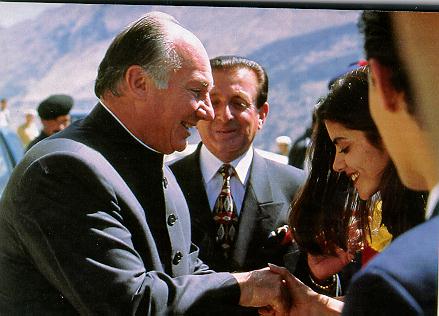THE AGA KHAN VISITS THE RECENTLY RESTORED BALTIT FORT IN THE HIMALAYAS

| The Heritage Society Presents... | Back to Heritage F.I.E.L.D |

"It's very impressive!" exclaimed the Prince as he walked down Baltit Fort's great stairway. "The architects Didier Lefort and Stephano Bianco, and indeed all the Pakistani craftsmen have done a splendid job in restoring this castle, breathing life into the very symbol of all culture in the valley of Hunza." he continued, expressing his gratitude to all those who, for the last five years, had devoted their efforts to saving the 11th century castle from ruin. Located some 2,800 metres above sea level, Baltit Fort is by far the most strategically sited medieval castle in the world, dominating the village of Baltit (renamed Karimabad in honour of the Prince) and overlooking Mount Rakaposhi, one of the highest summits in the Himalayan range, vast glaciers and deep gorges.
Legend has it that this fortress was built to house a Hunza Prince and his Balistinian princess whose alliance in marriage, it was hoped, would protect the kingdom. It was here, too, that the population sought shelter during conflicts with its various Shiite neighbours. Until 1950, Baltit Fort was home to the ruling Mirs of Hunza before gradually being left abandoned.
In 1989, Ghanzafar Ali Khan, a descendant of the Mirs, handed the fort to the Association for the Preservation of Baltit's Heritage. It was then that Aga Khan's foundation- which supports health, education and rural development projects around the world- proposed a plan to restore the fort to its former glory.
Protecting and restoring Baltit Fort was also the means for the foundation to apply itself to the preservation of all its surrounding environment, in particular the historic village, a masterpiece of stonemasonry, which like the fortress has fallen into a state of neglect. "Architecture is vital for preserving traditions", exclaimed the Prince. "But this ambitious project will only succeed with the support and the contribution of the local population."
 Artefacts dating from the Middle Ages are still being collected to
fill the fortress' museum, but the lack of exhibition showcases
allows one to appreciate all the more the architecture and layout
of the building: the small and sombre rooms, the magnificent
woodwork and masonry. On the roof stands a small Chinese bell,
symbol of the good relations the tiny former kingdom enjoys with
nearby China.
Artefacts dating from the Middle Ages are still being collected to
fill the fortress' museum, but the lack of exhibition showcases
allows one to appreciate all the more the architecture and layout
of the building: the small and sombre rooms, the magnificent
woodwork and masonry. On the roof stands a small Chinese bell,
symbol of the good relations the tiny former kingdom enjoys with
nearby China.
It is from this vantage point at the top of the fortress that the visitor can fully appreciate the wonders of this extraordinary part of the world. Far below, at the bottom of the Hunza valley flows the river of the same name and above it, opposite the fortress, stretch fields of crops which are irrigated by an extraordinarily sophisticated irrigation system designed to tap the glaciers. A present from the foundation, in the early Eighties, acting on the urgent plea of inhabitants, was all the equipment necessary to dig a new canal in the mountainside, over four miles in length.
When he visited the Ismaili community of Hunza for the first time in 1960, the young Prince was deeply affected by the abject poverty of the inhabitants. At the time, Karim Aga Khan had only just succeeded his grandfather to become the 49th Imam, heir to the Ismaili community, a branch of the Islam Shiites which boasts some 15 million loyal followers worldwide.
"The foundation has helped to provide the financial and technical means to aid the development of the valley be it agriculturally, or in the medical and educational areas. Hunza is the starting point of many big projects that are currently underway. We have already started to bring life back into the historical centre of the region, " he says.
Aware that all the benefits provided by the foundation have greatly provided their living conditions, the people of Hunza know no bounds in expressing their gratitude. To welcome their Imam, they spent days and nights decorating the road, filling their houses with flowers or etching welcome slogans in huge letters on the mountainside. But it was to be expected: they had waited ten years for the return of their spiritual leader.
During the extended festivities, Karim Aga Khan spent at least two days touring Hunza with Pakistani President Farooq Ahmad Leghari, who was on an official visit to Hunza which since 1947 has been part of Pakistan. Towards the end of his stay, the Aga Khan met his people in the intimacy of a religious ceremony, strictly reserved for Ismailis.
Report: Claudine Letourneur
Photos: Cyril Letourneur/saola
Hello! Magazine
Number 434, November 23, 1996.